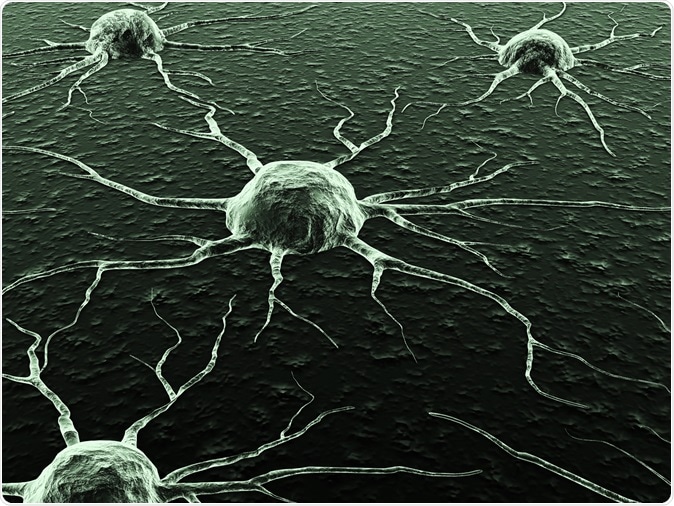A large amount of information has been gathered by researchers from University of Texas MD Anderson Cancer Center who were studying the molecular features of tumors and their subtypes. They were working on breast and four types of gynaecological cancers.
This could be paving the way for new, effective and targeted therapies say experts in the field. The team of researchers performed a comprehensive analysis of 2,579 cancer cases. The study led by Rehan Akbani, Associate professor of Bioinformatics & Computational Biology were published in the latest issue of the journal Cancer Cell.

Cancer Cells. Image Credit: BioMedical / Shutterstock
The analysis was a collaborative effort of National Cancer Institute and the National Human Genome Research Institute. It is part of the Pan-Cancer Atlas that is working towards analyzing cancers worldwide. It is available via The Cancer Genome Atlas (TCGA). Akbani explains that the aim of this large scale analysis is to understand the molecular make up of the cancers, their subtypes that can be differentiated and develop new therapeutic targets and strategies. He went on to say that their study has confirmed the molecular and genetic similarities between five types of cancers of breast and gynaecological organs. He explained that what they found needs to be understood better before the knowledge can be on clinical use and applied to therapeutics. As of now however, it remains a unique finding.
The results of the analysis showed that there are 16 distinct molecular features based on which five types of cancer subtypes can be classified. They also developed a decision flowchart or tree that could classify these patients into the subtypes based on six laboratory assessed and confirmed features. They also found that some subtypes showed high white blood cell counts. These may be responsive to immunotherapy treatment as well. The team noted that breast and gynaecological cancers were regulated by the estrogen hormone in unique ways. For example long non-coding RNAs (lncRNAs) were regulated by estrogen receptors and there was a connection between the lncRNA and the genes. They found that there were somatic copy-number alterations (SCNAs) and significantly mutated genes (SMGs) that could be called genetic aberrations. They noted 61 SNCAs and 46 SMGs. These had not been identified previously in these five types of tumors.
According to John Weinstein, chair of Bioinformatics & Computational Biology, who was part of the research team, this study adds to the TCGA Pan-Cancer Atlas projects that have analyzed 11,000 tumours in 33 different types of cancers. Dr. Christopher Benz, professor of cancer and developmental therapeutics at the Buck Institute for Research on Aging in San Francisco and a member of TCGA said that cancer patients would now have “the best shot at successful treatment”, if the genetic and molecular makeup of their cancers can be understood better. He added that this would provide “a new foundation for future cancer research efforts and clinical trials.” TCGA is being funded by the U.S. National Institutes of Health to the tune of $300 million and includes around 150 researchers from over two dozen centres in North America.
References